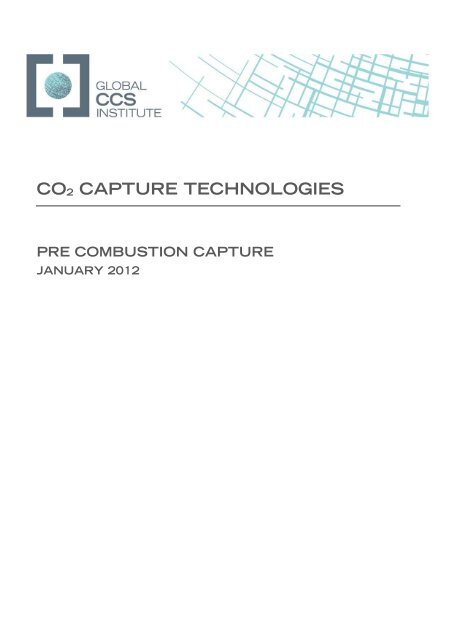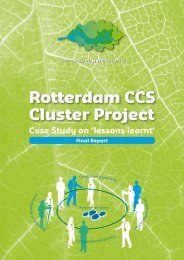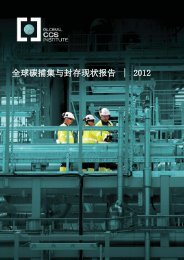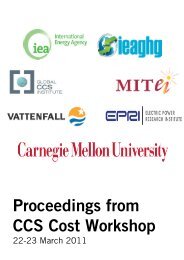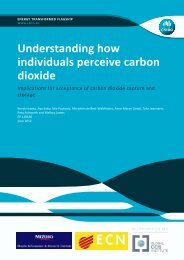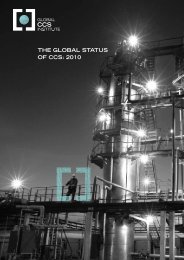pre combustion capture - Global CCS Institute
pre combustion capture - Global CCS Institute
pre combustion capture - Global CCS Institute
You also want an ePaper? Increase the reach of your titles
YUMPU automatically turns print PDFs into web optimized ePapers that Google loves.
GLOBAL <strong>CCS</strong> INSTITUTE – CO 2 CAPTURE TECHNOLOGIESCONTENTSPRE COMBUSTION CAPTURE ..................................................................................................... 3Introduction ................................................................................................................................ 3Pre Combustion Capture Technology ....................................................................................... 3Chemical Absorbents .......................................................................................................... 3Physical Absorbents ............................................................................................................ 3Pre-Combustion Capture Applications ...................................................................................... 4CO 2 Capture from Natural Gas ........................................................................................... 4CO 2 Capture from Natural Gas Reforming and Partial Oxidation ...................................... 4CO 2 Removal from Coal Gasification Plants ...................................................................... 5IGCC Design Options for CO 2 Capture ............................................................................... 5Pre-Combustion Capture – Current Status and Technology Providers ................................... 7TRL of Current IGCC Designs with Capture ....................................................................... 7TRL of Pre-Combustion Capture in other Applications ...................................................... 7Leading Providers of IGCC Technology ............................................................................. 7Leading Current Providers of AGR Processes for CO 2 Capture ........................................ 7Pre-Combustion CO 2 Capture – Challenges/ Future Direction ................................................ 7CO 2 Capture at Warm or Hot Gas Temperature................................................................. 8Other Processes for Separation of Hydrogen and CO 2 ...................................................... 8Energy Losses in IGCC with Capture and RD&D Needs ................................................... 8Potential Improvements to Supporting Technologies ....................................................... 10The Future of Pre-Combustion Capture Technology ....................................................... 10ACRONYMS AND SYMBOLS ................................................................................................ 12CO 2 Capture Technologies, Section 3 1
GLOBAL <strong>CCS</strong> INSTITUTE – CO 2 CAPTURE TECHNOLOGIESPRE COMBUSTION CAPTUREIntroductionThe oil, gas and chemical industries have been separating CO 2 from gas streams for decades. In most casesthe CO 2 is removed in order to meet the required downstream product requirements, whether natural gas,hydrogen or chemicals. The term <strong>pre</strong>-<strong>combustion</strong> <strong>capture</strong> has come into use relatively recently mostly in thecontext of gasification based power plants, particularly IGCC, where, in anticipation of requirements to limitCO 2 emissions, plant designs have been developed to convert the gas produced from gasification (henceforthreferred to as ‘syngas’) to hydrogen and CO 2 and to remove the CO 2 from the syngas stream prior to the<strong>combustion</strong> of the hydrogen rich gas in the gas turbine.Pre Combustion Capture Technology 1In natural gas processing, natural gas reforming, gasification and IGCC the ultimate <strong>capture</strong> of the CO 2 iscurrently accomplished under <strong>pre</strong>ssure by an acid gas removal (AGR) process of absorption in a solventfollowed by regenerative stripping of the rich solvent to release the CO 2 which with subsequent com<strong>pre</strong>ssioncan be sent to sequestration or supplied for EOR.There are two major generic types of ‘acid gas’ (i.e., CO 2 , H 2 S, COS) removal (AGR) solvents – chemical andphysical.Chemical AbsorbentsChemical absorbents (e.g., MDEA and other amines) react with the acid gases and require heat to reverse thereactions and release the acid gases. These processes generally have lower capital for AGR than physicalsolvents, but use larger amounts of steam-heat for solvent regeneration.Physical AbsorbentsPhysical absorbents (e.g., Selexol, Rectisol) dissolve acid gases <strong>pre</strong>ferentially with increasing <strong>pre</strong>ssure. Theabsorbed acid gases are released from the solvent when <strong>pre</strong>ssure is decreased and temperature is increased.Significantly less steam-heat is required for solvent regeneration than with chemical solvents. The Rectisolprocess, which uses chilled methanol, generally has a higher capital cost, but provides the most completeremoval.The <strong>pre</strong>-<strong>combustion</strong> removal of CO 2 from syngas has some thermodynamic advantages over PCC. Naturalgas processing, reforming and gasification are conducted under <strong>pre</strong>ssure (typically > 40 bar) where the higherpartial <strong>pre</strong>ssure of CO 2 enables the use of a physical solvent (e.g. Selexol) that enables some of the CO 2 to beregenerated at <strong>pre</strong>ssure through a series of flash drums thereby reducing the auxiliary power required for CO 2com<strong>pre</strong>ssion. The efficiency penalty for adding PCC to SCPC is 10-11% points in efficiency whereas thepenalty for the addition of <strong>pre</strong> <strong>combustion</strong> <strong>capture</strong> to an IGCC is generally 7-8% points.A generic process flow diagram for the acid gas removal section of an IGCC plant designed for CO 2 <strong>capture</strong> isshown in Figure 3-1. The first absorber/stripper section is for the removal of a H 2 S-rich stream that is usuallysent to a Claus unit for recovery of elemental sulphur for sale. The sulphur free gas is then sent to a secondabsorber for removal of the CO 2 and the hydrogen rich syngas is sent to the gas turbine power block. The CO 2rich solvent is sent to a stripper for solvent regeneration and the stripped CO 2 is dried and com<strong>pre</strong>ssed fortransportation and storage.1 Engineering Economic Evaluations of Advanced Coal Technologies with Carbon Capture and Storage -2011.EPRI Report #1022025. G. Booras June 2011CO 2 Capture Technologies, Section 3 3
GLOBAL <strong>CCS</strong> INSTITUTE – CO 2 CAPTURE TECHNOLOGIESFigure 3-1 Typical IGCC AGR Process Arrangement for CO 2 CaptureTypically all the solvents can accomplish >90% CO 2 removal, but the overall percentage of <strong>capture</strong> dependson the amount of water-gas shift conducted. For a 600 MW IGCC plant the space requirements for the watershiftreactor(s), CO 2 removal, drying, and com<strong>pre</strong>ssion are similar for all solvent options, about 0.6-0.8hectares.Pre-Combustion Capture ApplicationsCO 2 Capture from Natural GasMuch of the World’s sources of natural gas contain CO 2 and Hydrogen Sulfide (H 2 S). The H 2 S, and in manycases the CO 2 , must be removed to meet the purity requirements of natural gas pipelines and for theproduction of Liquefied Natural Gas (LNG). The H 2 S and CO 2 can each be removed separately or together(bulk removal) from the natural gas through the use of one of several commercially available AGR processes.At most of the currently operating natural gas processing plants the H 2 S is converted to elemental sulphur forsale and the <strong>capture</strong>d CO 2 is vented. However there are several projects where the CO 2 is com<strong>pre</strong>ssed forsequestration or for use in Enhanced Oil Recovery (EOR).CO 2 Capture from Natural Gas Reforming and Partial OxidationThree processes - Steam Methane Reforming (SMR), Autothermal Reforming and Partial Oxidation (withoxygen) - are widely used commercially for the production of hydrogen and chemicals such as ammonia,methanol etc from natural gas. These processes can also be used with refinery gas, propane, butanes ornaphtha as the feed. All three processes produce a syngas containing hydrogen, carbon monoxide (CO), CO 2and excess steam which is cooled and passed through a catalyst bed where the CO is reacted with steam toproduce hydrogen and CO 2 (known as a shift reactor which produces shifted syngas) The CO 2 can then beremoved from the shifted syngas by using currently commercially available AGR processes. Most of the CO 2from these plants is currently vented. However in plants that produce hydrogen for ammonia manufacture theco-produced CO 2 is sometimes used to react with ammonia to produce urea.There are a few projects in operation and others being considered where the CO 2 removed from natural gasreforming or partial oxidation is com<strong>pre</strong>ssed and used for sequestration or EOR.CO 2 Capture Technologies, Section 3 4
GLOBAL <strong>CCS</strong> INSTITUTE – CO 2 CAPTURE TECHNOLOGIESCO 2 Removal from Coal Gasification PlantsCO 2 removal from coal gasification derived syngas is a mature commercial process widely practicedthroughout the world. A couple of coal gasification plants are noted that are currently capturing CO 2 for use inEOR.The gasification of coal, petroleum coke and heavy oils with oxygen are in wides<strong>pre</strong>ad commercial use for theproduction of chemicals such as ammonia, urea, methanol, dimethyl ether, SNG, gasoline and othertransportation fuels via the Fischer Tropsch process. In these plants the produced syngas is cleaned ofparticulate matter and subjected to the shift reaction to produce the appropriate CO/H 2 ratio for subsequentsynthesis. The sulphur in the feedstock is converted to H 2 S and carbonyl sulphide (COS). Commercial shiftcatalysts are available for use on either sulphur containing syngas (sour gas) or on sulphur free syngas (sweetgas).With sour gas the shift catalyst will also convert the COS to H 2 S. The H 2 S and CO 2 can each be removedseparately or together (bulk removal) from the shifted syngas through the use of one of several commerciallyavailable AGR processes. An alternative process scheme is the removal of the sulphur species from thesyngas by COS hydrolysis followed by an AGR process before conducting the shift reaction on the sweet (i.e.sulphur free) syngas.IGCC Design Options for CO 2 CaptureThere are several IGCC plants in operation in several countries but to date none of them has incorporated CO 2<strong>capture</strong>. However several IGCC projects that include <strong>capture</strong> are being developed and there is one project, theKemper County project in Mississippi, that is in construction.In an IGCC plant, CO 2 <strong>capture</strong> is accomplished as <strong>pre</strong>viously described for gasification plants. One or twostages of water-gas shift are used on the particulate free syngas and the addition of steam may be necessarydependent on the specific gasification technology employed. This is followed by gas cooling and the separateremoval of H 2 S and CO 2 in two AGR absorption/stripping units arranged in series. The H 2 S rich stream usuallyis fed to a Claus plant (sulphur recovery unit or SRU) and the CO 2 is dried and com<strong>pre</strong>ssed for sequestrationor use in EOR. Tail gas from the SRU can be recycled to the AGR inlet to improve CO 2 recovery. CO 2 <strong>capture</strong>may be added as a retrofit or included in the design of a new plant. Figure 3-2 is a block flow diagram of IGCCwith CO 2 <strong>capture</strong>. It shows the typical IGCC arrangement for oxygen blown gasification processes. Howeverthe MHI and the Southern Company’s TRIG TM processes are both air blown. For these air blown processes theAir Separation Unit (ASU) is essentially replaced with an additional main air com<strong>pre</strong>ssor to augment the airextracted from the gas turbine com<strong>pre</strong>ssor as air supplied to the gasification island.In an IGCC plant with CO 2 <strong>capture</strong> the syngas fuel to the gas turbine is mostly comprised of hydrogen, typicallydiluted with nitrogen. Although the CO 2 <strong>capture</strong> process from gasification syngas is a mature commercialtechnology, hydrogen firing in large F Class gas turbines and the whole IGCC plant operation incorporating<strong>capture</strong> in an integrated manner has yet to be demonstrated.CO 2 Capture Technologies, Section 3 5
GLOBAL <strong>CCS</strong> INSTITUTE – CO 2 CAPTURE TECHNOLOGIESFigure 3-2Process Flow Diagram of Generic IGCC Plant Showing Retrofit Modifications for CO 2 CaptureIGCC Retrofit Addition of CaptureThere are a few IGCC plants in operation without <strong>capture</strong> however prospectively most IGCC projects willalmost certainly plan to incorporate <strong>capture</strong> in the original design.If CO 2 <strong>capture</strong> was to be added to an IGCC design that did not envisage the future addition of <strong>capture</strong> thereare additional cost and performance penalties over a new built plant with <strong>capture</strong>. The addition of the shiftreactor results in less syngas energy being delivered to the power block. It also results in a higher syngas flowto the AGR section so that additional absorber capacity will be needed.Additional ASU, Gasification and gas clean-up capacity will be needed to fully load the gas turbines when Shiftis added. If this oversizing is included in the initial IGCC investment this version of ‘<strong>capture</strong> ready’ would thenpermit full gas turbine output with hydrogen when <strong>capture</strong> is added.Addition of sour shift increases gas flow to the AGR by 45-60% (particularly for the dry coal fed gasifiers withhigh CO content). The AGR would be unable to take the extra flow unless there was <strong>pre</strong>-investmentoversizing. It may therefore be necessary to add a parallel absorber or replace the entire AGR plant (with anew two column absorption system) if <strong>capture</strong> is to be added to an existing IGCC designed without <strong>capture</strong>.Alternatively the original AGR (focused on H 2 S Removal) could be retained and a Sweet shift added after theAGR with a simpler bulk CO 2 removal AGR (ADIP, MDEA, Selexol) added after shift. This would minimizeintrusion into existing plant. This trade off of Sour versus Sweet Shift needs to be examined and may differamong the different gasification Technologies. Sweet shift may incur additional efficiency and output penalties.Quench type gasifiers would probably favour the use of sour Shift.CO 2 Capture Technologies, Section 3 6
GLOBAL <strong>CCS</strong> INSTITUTE – CO 2 CAPTURE TECHNOLOGIESPre-Combustion Capture – Current Status and Technology ProvidersTRL of Current IGCC Designs with CaptureThere are several commercial sized IGCC projects with <strong>capture</strong> in and one (Kemper County) underconstruction. However, the designs of IGCC plants incorporating <strong>capture</strong> using current <strong>capture</strong> technologyincur high energy losses of 7-8% points through the addition of <strong>capture</strong>. The energy losses occur in many partsof the IGCC flow scheme.For an IGCC plant with <strong>capture</strong> based on current technology, the TRL of the major components of the ASU,gasification, gas cooling, shift, sulphur removal and CO 2 <strong>capture</strong> are all at TRL 9.TRL of Pre-Combustion Capture in other ApplicationsThe <strong>capture</strong> of CO 2 from natural gas processing, natural gas reforming and coal gasification is commerciallypracticed worldwide (i.e. TRL 9). In a few plants the <strong>capture</strong>d CO 2 is being sequestered or used for EOR.Leading Providers of IGCC TechnologyThe leading providers of gas turbine based power blocks for the IGCC application with <strong>capture</strong> are GeneralElectric, Siemens and MHI. Each of these companies can also provide gasification technologies so that theyare in a good position to supply overall IGCC technology packages when linked with ASU, shift and AGRtechnology providers.The leading providers of the various IGCC component technologies described in this Section are listed inTable 3-1.Table 3-1 Leading Providers of IGCC Component TechnologiesTechnology Leading Provider CompaniesAir Separation Air Products, Praxair, Air Liquide, LindeGasification Heavy Oil – General Electric, Shell, Lurgi,Fixed Bed – Lurgi/Air Liquide FBDB, Envirotherm BGLFluid Bed - Southern/KBR TRIG TM , Uhde - HTWinkler, SES U Gas, HRL IDGCCEntrained Flow - General Electric, ConocoPhillips E Gas TM , ECUST, Shell, Siemens, Uhde,MHI (Mitsubishi Heavy Industries)ShiftAcid GasRemovalGas TurbinesHaldor Topsoe, Sud Chemie, Johnson MattheyDow and BASF (MDEA), UOP (Selexol), Lurgi/Air Liquide and Linde (Rectisol), Shell(Sulfinol, ADIP).General Electric, Siemens, MHILeading Current Providers of AGR Processes for CO 2 CaptureThe leading suppliers of AGR processes are Dow and BASF for MDEA, UOP for Selexol, Lurgi/Air Liquide andLinde for Rectisol, Shell for Sulfinol and ADIP.Pre-Combustion CO 2 Capture – Challenges/ Future DirectionAlthough the efficiency loss of 7-8 percentage points for addition of <strong>capture</strong> to IGCC is currently less than forPCC with MEA in SCPC, it is still very high. The major thrust in RD&D for IGCC designs with <strong>capture</strong> is toreduce the energy penalty. While the additional capital cost of <strong>capture</strong> equipment is not insignificant it is netpower output loss that is the most significant economic detriment of <strong>capture</strong> addition.CO 2 Capture Technologies, Section 3 7
GLOBAL <strong>CCS</strong> INSTITUTE – CO 2 CAPTURE TECHNOLOGIESCO 2 Capture at Warm or Hot Gas Temperature 2Current AGR processes operate at low temperatures below 40°C. Cooling the syngas to that temperaturecondenses water from the syngas with an accompanying loss of energy and mass. If the AGR could beaccomplished at a higher temperature (e.g. at the temperature of the outlet of the shift reactor) there would belower energy losses and more motive mass to the gas turbine.RTI is developing a process for the removal of sulphur species from syngas at temperatures > 230°C using azinc oxide based sorbent in a transport type reactor with oxidative regeneration of the loaded sorbent. This hasbeen tested at small scale on a slipstream at the Eastman gasification plant in Kingsport, TN and a larger scaleunit is to be installed and tested on a 50 MW equivalent slip stream at the Tampa Electric IGCC plant inFlorida.However to take full advantage of this process there must also be processes for the hot removal of tracecontaminants (Cl, As, Hg etc) and CO 2 . The Benfield and CataCarb processes that use a solution ofPotassium Carbonate are possible candidates however the sorbent regeneration is at atmospheric <strong>pre</strong>ssure.A more promising approach is the use of a high temperature membrane that could potentially separatehydrogen and CO 2 while producing each at relatively high <strong>pre</strong>ssure.Membrane Separation of Hydrogen and CO 2The Eltron high temperature metallic membrane for hydrogen transport has had some success at a smallscale. Eastman Chemical has been brought on as a partner and a scale up is planned at the Eastmangasification site. This technology has the potential of incorporating the shift catalyst in its design. A <strong>pre</strong>liminaryEPRI evaluation of this technology, when <strong>pre</strong>ceded by RTI’s warm gas clean-up process (using Zinc oxide),showed significant improvement in efficiency. The ability to produce both the hydrogen and CO 2 at <strong>pre</strong>ssureresults in reduced auxiliary power demand.Another type of membrane is being developed by MTRI (Membrane Technology Research Inc) for testing onsyngas at the NCCC (National Carbon Capture Center). The US DOE is supporting both Eltron and MTRI intheir membrane process development. These membrane technologies are considered to be at TRL (TechnicalReadiness Level) 4 to 5.Other Processes for Separation of Hydrogen and CO 2The use of chilled ammonia and cryogenic processes for CO 2 <strong>capture</strong> are being studied and have the potentialto produce the <strong>capture</strong>d CO 2 at <strong>pre</strong>ssure thereby reducing the auxiliary power load. An ammonium carbonate– ammonium bicarbonate (AC-ABC) process is being developed, under DOE-NETL funding, by StanfordResearch <strong>Institute</strong> (SRI) for <strong>pre</strong>-<strong>combustion</strong> <strong>capture</strong> of CO 2 . SRI had <strong>pre</strong>viously conducted some of the initialexperimental work using the same AC-ABC system for post <strong>combustion</strong> CO 2 <strong>capture</strong> that formed the basis forthe Alstom chilled ammonia PCC process. The <strong>pre</strong> <strong>combustion</strong> AC-ABC process is at about TRL 4-5. The useof a cryogenic process for the <strong>pre</strong>-<strong>combustion</strong> removal of CO 2 by chilling the shifted syngas stream has alsobeen proposed but not yet tested. This is considered to be at TRL 2 to 3.Energy Losses in IGCC with Capture and RD&D Needs 3Although there is additional capital involved, the largest component of the poor economic performance in <strong>pre</strong><strong>combustion</strong><strong>capture</strong> systems is the loss of energy involved. Much of the RD&D effort is aimed at reducing theenergy losses due to <strong>capture</strong> in the various process steps but one of the greatest improvements to the overallIGCC technology is the development of high firing temperature larger gas turbines of higher efficiency. This2 Evaluation of Potential Improvements in IGCC Pre-<strong>combustion</strong> CO 2 Capture. EPRI Report # 1021640.A.Bhown, N.Holt December 2010.3 Gasification Technology Status- December 2010. Section 6 Ongoing RD&D of IGCC Improvements. EPRIReport # 101966. N.Holt. December 2010.CO 2 Capture Technologies, Section 3 8
GLOBAL <strong>CCS</strong> INSTITUTE – CO 2 CAPTURE TECHNOLOGIESlatter improvement will occur regardless of any requirement for CO 2 <strong>capture</strong>. The major energy losscomponents and the RD&D needed to reduce these losses are shown in Table 3-2:Table 3-2 Pre Combustion Energy Losses and RD&D NeedsPre-Combustion CaptureEnergy Loss ComponentThe ASU has high auxiliarypower demand for the mainair com<strong>pre</strong>ssor, oxygen andnitrogen com<strong>pre</strong>ssionReduction in syngaschemical heating value fromthe endothermic shiftreactionAddition of steam to the shiftreducing steam turbineoutputEnergy losses from coolingthe shifted syngas to thetemperatures required forthe current AGR processesCom<strong>pre</strong>ssion energy to raisethe <strong>pre</strong>ssure of the CO 2recovered from AGRprocessesLimits on air extraction fromgas turbines increase theauxiliary load for the main aircom<strong>pre</strong>ssor supplying air tothe ASUCom<strong>pre</strong>ssion of the CO 2 topipeline <strong>pre</strong>ssureComments/RD&D Needed R&D in Progress TRL ofRD&DDevelopment of ASU process with lowerpower demand.This loss is inevitable with the shift reactionImproved shift catalysts that function at alower steam/CO ratioWarm gas clean up for sulphur species andtrace element removalMembranes to produce both CO 2 andHydrogen at high <strong>pre</strong>ssureGas turbine com<strong>pre</strong>ssor designs that permitair extraction when firing hydrogenProduce CO 2 at higher <strong>pre</strong>ssure. Improvedcom<strong>pre</strong>ssion concepts. Improved heatrecoveryAir Products ITM 1mt/d moving to 100mt/d oxygenAll shift vendors50 MW RTI test atTampaEltron test atEastmanAll gas turbinevendors. DOEsupport of GE andSiemens. Japan forMHI.6movingto 7Various6-87movingto 84movingto 57RamGen 5Reduced firing temperatureof hydrogen fired gasturbinesHigher firing temperature larger gas turbinesfor Hydrogen provide higher efficiency andeconomies of scale. Need larger gasifiers toprovide the hydrogen fuel for the larger gasturbinesAll gas turbinevendors. DOEsupport for GE &Siemens. Japan forMHI5CO 2 Capture Technologies, Section 3 9
GLOBAL <strong>CCS</strong> INSTITUTE – CO 2 CAPTURE TECHNOLOGIESPotential Improvements to Supporting TechnologiesASUThe Ion Transport Membrane (ITM) for low cost oxygen production currently being developed by Air Productswith major DOE support promises reduced auxiliary power usage 4 . The ceramic membrane exclusively allowsonly oxygen ions to migrate through the solid. The process takes place at very high temperatures of ~1,000C(~1,832F) and moderate <strong>pre</strong>ssure across the membrane is required. The current test unit is 1 mt/d and plansare moving forward for a 100 mt/d unit to be operational in 2012. The integration of this technology into IGCCor Oxy <strong>combustion</strong> plants is a significant challenge.ShiftThe shift reaction can be conducted on the sour syngas before sulphur removal (‘sour shift’) or after sulphurremoval (‘sweet shift’). Industrial catalysts are available for both types. Most IGCC + <strong>CCS</strong> designs use the sourshift approach. The major shift catalyst suppliers (SudChemie, Haldor Topsoe, and Johnson Matthey) andShell have active programs to improve the performance of shift catalyst to operate at lower steam/CO ratioswithout carbon lay down or methanation issues. This is particularly important for dry coal fed gasifiers with theirhigh CO content in the raw syngas. In an IGCC + <strong>CCS</strong> plant design based on dry fed gasifiers the steam oftenhas to be taken from the steam cycle to meet the shift catalyst requirements thereby reducing the steamturbine output and adversely affecting the overall performance and plant efficiency.Gas Turbines for HydrogenF class gas turbines have not yet been demonstrated commercially with hydrogen fuel however by reducingthe firing temperature (which reduces power output and efficiency) GE, Siemens and MHI do offer F class gasturbines with commercial guarantees.Since 2005 GE and Siemens have been developing advanced gas turbine technologies under a joint DOEsponsored initiative that is aimed at reducing syngas turbine emissions and improving efficiency of IGCCapplications incorporating <strong>CCS</strong>.The main elements of the programs are higher firing temperatures, advanced sealing and cooling, andadvanced materials and coatings to allow higher temperature operation with high hydrogen content syngas.Another goal is to achieve low NOx emissions with lower use of diluent nitrogen.Siemens has estimated that 8-9 per cent efficiency points are lost to IGCC plant designs when CO 2 Capture isincluded but that 5% efficiency can be gained back by the use of Advanced high hydrogen fired gas turbinetechnology. Siemens is currently offering their 8000 H gas turbines for natural gas firing and under the DOEjoint program plans to adapt this design to the IGCC application.MHI has announced plans for J type gas turbines with a firing temperature of 1600°C (100°C higher than the Gturbines) and a power output about 1.2 times that of G turbines. The target availability for the J turbine onnatural gas is 2011 with the first operation in 2013. The higher efficiency and greater output will providemarked improvements in IGCC economics. At the 2010 Gasification Technologies Conference, MHI outlined afuture trajectory of advanced gas turbines for IGCC with the J class availability about 2017, further 1700°C gasturbines beyond 2020 and later integration with fuel cells.The Future of Pre-Combustion Capture TechnologyThe next key event for the advance of <strong>pre</strong>-<strong>combustion</strong> <strong>capture</strong> technology will be the integrated operation ofthe first IGCC plant with <strong>capture</strong> at the Kemper County IGCC plant in Mississippi in 2014. This will hopefully befollowed by some of the other IGCC projects under development.Additional projects recovering CO 2 from natural gas processing (e.g. Gorgon) and possibly from natural gasreforming will also enter operation in the next few years.4 Scale up and Integration of Ion Transfer Membrane Oxygen Production Technology. EPRI # 1018956CO 2 Capture Technologies, Section 3 10
GLOBAL <strong>CCS</strong> INSTITUTE – CO 2 CAPTURE TECHNOLOGIESThere is a very active program underway on most of the RD&D elements identified in Table 3-1 with fundingfrom the DOE and the technology suppliers. EPRI 5 and DOE have identified a roadmap of IGCC technologydevelopments that can potentially improve the IGCC efficiency to a level that matches or exceeds that of thecurrent IGCC technology without <strong>capture</strong>. This is illustrated in Figure 3-3. The addition of <strong>capture</strong> with currenttechnology reduces the efficiency by about 8 percentage points. The higher firing temperature G class gasturbines increase it by about 2.5 per cent. The use of ITM for the ASU can add another 1% to efficiency. Theuse of feeding the coal to the gasifier as a coal in liquid CO 2 slurry is projected to improve efficiency by about2%. Incorporation of the RTI and Eltron advanced <strong>capture</strong> processes, together with the other advances isprojected to recover the 8% efficiency loss with the current <strong>capture</strong> technologies.With IGCC there are multiple pathways of improvements using different gasification technologies which mayfind particular application more favourably in certain climate conditions, locations and coal types. Figure 3-3indicates an improvement from the use of a coal in liquid CO 2 slurry that would improve the efficiency of slurryfed gasifiers particularly for low rank coals. For dry coal fed gasifiers the development of a coal pump couldproduce similar efficiency gains.4038Net Plant Efficiency(%, HHV Basis)36343230Figure 3-3 IGCC Developments to recover Energy Losses from CO 2 Capture5 The Future of IGCC Technology – CCPC-EPRI IGCC Roadmap Results. R. Schoff (EPRI). IEA CCT 2011.Zaragoza, Spain May 10, 2011CO 2 Capture Technologies, Section 3 11
GLOBAL <strong>CCS</strong> INSTITUTE – CO 2 CAPTURE TECHNOLOGIESACRONYMS AND SYMBOLSAFBC Atmospheric Fluidized Bed CombustionAGRAcid gas removalAQCS Air Quality Control SystemASUAir Separation UnitB&W Babcock & WilcoxBaraBars absoluteBargBars gaugeBFW Boiler feedwaterBPBritish PetroleumBtuBritish thermal unitCCCombined CycleCCGT Combined Cycle Gas TurbineCCPI Clean Coal Power Initiative<strong>CCS</strong>CO 2 <strong>capture</strong> and Storage (or Sequestration)CCTClean Coal TechnologyCFCapacity FactorCFBCirculating fluidized bedCHPCombined Heat and PowerCO 2Carbon dioxideCOECost of electricityCOPConocoPhillipsCTCombustion TurbineDOEU. S. Department of EnergyDOE NETL Department of Energy National Energy Technology LaboratoryECUST East China University of Science and TechnologyEEPR European Energy Programme for RecoveryEIAEnergy Information AdministrationEOREnhanced Oil RecoveryFBCFluidized-bed <strong>combustion</strong>/combustorFEED Front End Engineering DesignFGDFlue gas desulphurizationFOAK First of a kindF-TFischer Tropschft 3Cubic feetFWFoster WheelerFWIFoster Wheeler ItalianaGHG Greenhouse GasGIGasification IslandGJGigajoulegpmGallons per minute (US)GTGas TurbineH 2 SHydrogen sulfideHgAMercury absoluteHHVHigher heating valueHRSG Heat recovery steam generatorHPHigh <strong>pre</strong>ssureIEAInternational Energy AgencyIGCC Integrated Gasification Combined CycleIPIntermediate <strong>pre</strong>ssureIPPIndependent power producerkJKilojoulesKBRKellogg, Brown & RootLCALife Cycle AnalysisLCOE Levelised Cost of ElectricityCO 2 Capture Technologies, Section 3 12
GLOBAL <strong>CCS</strong> INSTITUTE – CO 2 CAPTURE TECHNOLOGIESLHVLPLSTKmtMDEAMMBtuMPaMTGMTONCCCNDRCNETLNGCCNH 3Nm 3NO XNSPSOCGTO&MPCPCCppmvPRBPSDFpsiapsigR&DRD&DRQRTIRWESCFDSNGSCPCSCRSO 2SRUststpdTCRTFCTPCUSCUS EPAWGCULower heating valueLow <strong>pre</strong>ssureLump Sum TurnkeyMetric tonMethylDiethanolamineMillion BtuMega PascalMethanol to GasolineMethanol to OlefinsNational Carbon Capture CenterNational Development and Reform Commission (China)National Energy Technology LaboratoryNatural Gas Combined CycleAmmoniaNormal cubic metersNitrogen oxidesNew Source Performance StandardsOpen Cycle Gas turbineOperation and maintenancePulverized CoalPost Combustion Captureparts per million by volumePowder River Basin (Coal)Power System Development FacilityPounds per square inch absolutePounds per square inch gageResearch & DevelopmentResearch, Development and DemonstrationRadiant Quench (GE)Research Triangle <strong>Institute</strong>Rheinische Westphalien ElectricidadeswerkeStandard Cubic Feet per daySubstitute Natural GasSupercritical Pulverized CoalSelective catalytic reductionSulphur dioxideSulphur Recovery UnitShort ton (2000 pounds)Short tons per dayTotal Capital RequirementTotal Field CostTotal Plant CostUltra SupercriticalUS Environmental Protection AgencyWarm gas clean upCO 2 Capture Technologies, Section 3 13


